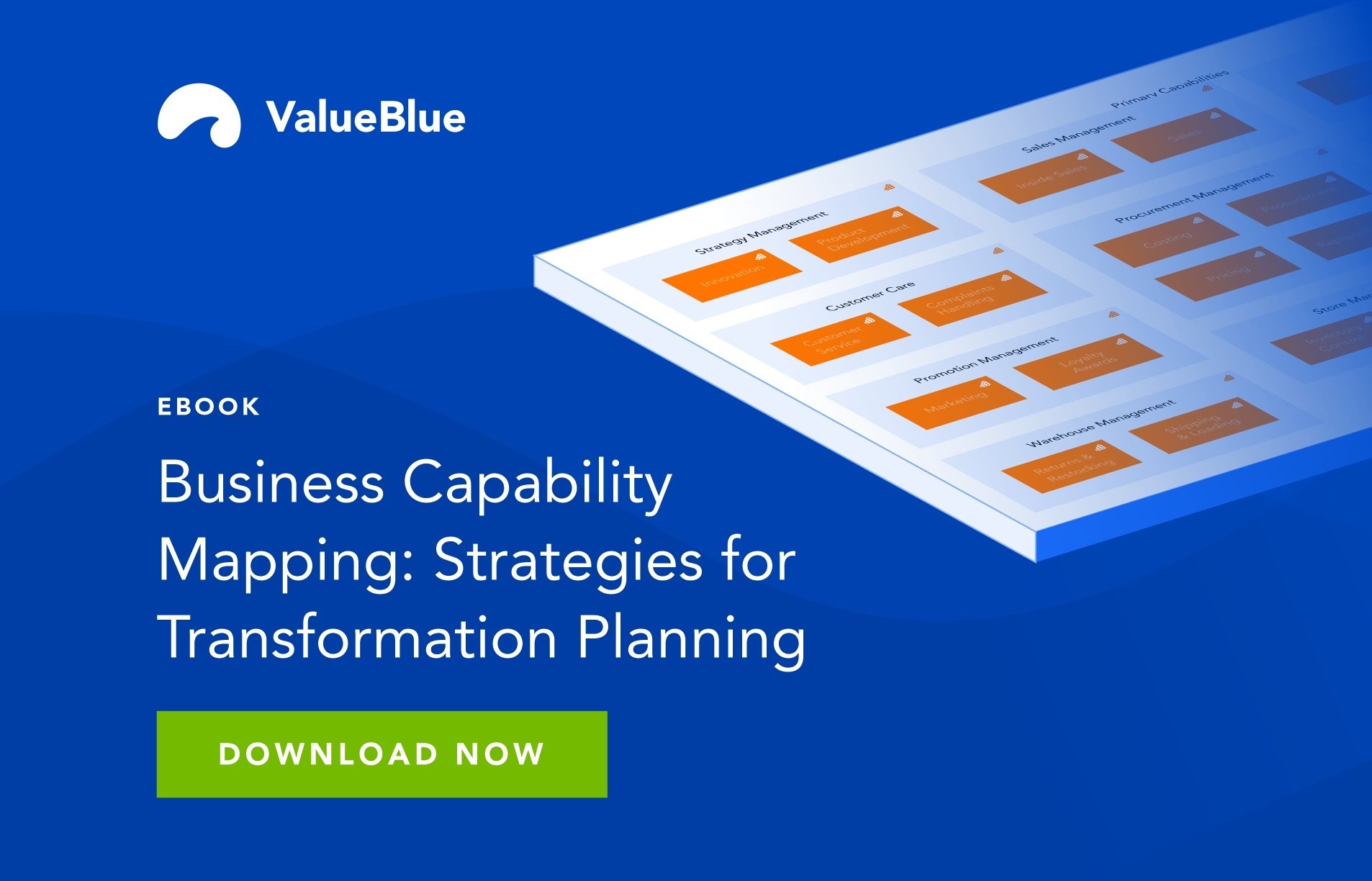The C4 Model in Enterprise Architecture explained
Enterprise Architecture (EA) has long been a critical discipline for organizing and guiding the design of IT systems within an organization. The complexity of modern systems, with their growing number of components, dependencies, and interactions, has made effective communication and documentation more crucial than ever. This is where the C4 Model steps in as a powerful tool for visualizing and documenting software architectures.
In this post, we explore how the C4 Model can transform how you approach Enterprise Architecture, making it more accessible and effective.
Table of contents:
- The C4 Model and its four core components
- Benefits of Implementing the C4 Model in EA
- Integrating the C4 Model into Enterprise Architecture Practices
- Best Practices for Adopting the C4 Model in EA
The C4 Model and its four core components
The C4 Model was created to simplify architectural documentation. Traditional documentation techniques often result in overly complex diagrams that are difficult to understand and maintain. The C4 Model addresses these problems by providing a hierarchical approach that divides the system’s architecture into four distinct levels of abstraction, each with its own focus and intended audience:
- Context Diagrams: At the top of the hierarchy, the Context Diagram provides a high-level overview of the entire system. It focuses on the system’s external boundaries, showing how it interacts with users, external systems, and other entities. This diagram provides a clear picture of the system's role in a larger ecosystem and helps both technical and non-technical stakeholders understand its place.
- Container Diagrams: The next level down zooms in on the system's internal structure. The Container Diagram breaks the system into major containers, representing web servers, databases, desktop applications, and services. It highlights how each container communicates with others and shows their responsibilities and boundaries. This diagram is essential for understanding the system's major components without getting bogged down in too much detail.
- Component Diagrams: Moving deeper, the Component Diagram dives into the individual containers, breaking them into smaller components or classes. This is where the design decisions start to become more specific, illustrating how different parts of a container interact with each other. While still abstract enough to avoid overwhelming the viewer, this diagram provides a better sense of how a system is structured at the implementation level.
- Code Diagrams: Finally, the deepest level of the C4 Model is the Code Diagram, which focuses on the implementation details. This diagram does not necessarily show all lines of code but illustrates the relationships between classes, modules, or other code-level entities. It’s the most detailed view and gives developers an essential understanding of the codebase’s structure.
The C4 Model’s approach allows architects to cater to different audiences by presenting information at varying levels of granularity. For example, a CEO may need to look at a Context Diagram, while a developer might need to work with Component or Code Diagrams.
Benefits of implementing the C4 Model in Enterprise Architecture
Adopting the C4 Model for your enterprise architecture has several advantages. It goes beyond just being a tool for drawing diagrams – its real power lies in enhancing communication, promoting consistency, and supporting long-term growth.
- Enhanced communication
One of the biggest challenges in EA is ensuring that all stakeholders can understand the system. Traditional architectural documentation often suffers from being too technical or too abstract, leaving key groups either lost in jargon or uninformed about how the system works.
The C4 Model bridges this gap by using a language of abstraction suitable for a wide range of audiences. Visualizing the system in layers allows non-technical stakeholders to see the big picture (Context Diagram) while giving developers the granularity they need to make implementation decisions (Code Diagrams). This clear communication leads to better decision-making, less confusion, and more efficient collaboration across teams.
- Consistency in documentation
The C4 Model also ensures consistency across architectural documents. Its hierarchical nature provides a structured way to document systems, helping organizations avoid the inconsistency that often arises when different teams or individuals adopt their own approaches to documentation.
This uniformity improves the clarity of the architecture and makes it easier to update the documentation as the system evolves. When a new container or component is added, it can be placed into the existing structure without disrupting the overall documentation flow. This makes it far easier to keep architectural diagrams up to date as systems grow.
- Facilitating onboarding and training
Understanding the architecture of an existing system can be one of the biggest hurdles for new team members or contractors to work effectively. The C4 Model offers an excellent way to onboard new hires quickly. By following the model’s layers, they can get a broad understanding of the system’s purpose and progressively dive deeper into the more detailed parts of the architecture. This process mirrors the learning journey many developers take when trying to comprehend a new system, ensuring that they aren’t overwhelmed by the complexity from the start.
Integrating the C4 Model into Enterprise Architecture practices
Adopting the C4 Model into an organization’s EA practice is not a one-size-fits-all process. While the model provides a structured framework, it is essential to integrate it in a way that works best for your organization’s specific needs and goals.
- Alignment with EA Frameworks
Many EA frameworks, such as TOGAF, focus on aligning IT with business strategies and improving operational efficiency. The C4 Model complements these frameworks by providing a clear visual representation of the architecture at multiple levels. By mapping the C4 diagrams to key EA entities – such as data, applications, and IT landscapes – organizations can better understand how architectural decisions align with business objectives.
For example, an organization using TOGAF might adopt the C4 Model to create container diagrams that map the specific technology choices supporting business goals. By tying architectural components directly to business value, the C4 Model can help align IT teams and business stakeholders.
- Tooling and implementation
One of the C4 Model's strengths is that it can be implemented using a variety of tools. Using these tools, EA teams can create and maintain their C4 diagrams, collaborating more effectively and ensuring everyone is on the same page regarding system design and evolution.
- Case studies and real-world applications
Numerous organizations have successfully adopted the C4 Model to improve their enterprise architecture documentation. Companies in various industries, from fintech to retail, have reported that using the C4 Model has helped streamline communication, reduce misunderstandings, and ultimately lead to better architectural decisions.
In a case study involving a global financial institution, the C4 Model was implemented to restructure its enterprise architecture. By adopting a C4-based approach, the team could document complex systems in a more digestible way, improve communication across technical and non-technical teams, and enable faster decision-making on technology investments.
Best practices for adopting the C4 Model in Enterprise Architecture
While the C4 Model offers robust tools, implementing it effectively requires careful planning and ongoing adaptation.
- Customization and flexibility
The C4 Model is not a rigid methodology – it’s a flexible framework that you can adapt to your organization and systems. While the four levels of diagrams provide a consistent structure, teams should feel free to adjust the model as necessary. For example, if specific components don’t fit neatly into the container diagram, they might warrant a new sub-diagram or an alternative representation.
- Continuous improvement
Systems evolve, and so should your architectural diagrams. The C4 Model encourages regular updates and iterations to ensure the documentation reflects system changes. This keeps the architecture relevant and ensures that the documentation continues to serve as a valuable tool for decision-making.
- Stakeholder engagement
Successful adoption of the C4 Model relies on engagement from all relevant stakeholders. Architects, developers, business analysts, and even end users should be involved in creating and reviewing the diagrams. This ensures that the architecture is not only technically sound but also aligned with business needs and goals.
Adopt a structured approach to visualizing complex systems
The C4 Model- offers a clear, structured, and adaptable approach to documenting and visualizing enterprise architectures. By breaking down complex systems into easily digestible layers,
As you explore the advantages of the C4 Model, you may also be interested in discovering how our tool can further enhance your Enterprise Architecture. Contact us today for a free demo.

.png)

